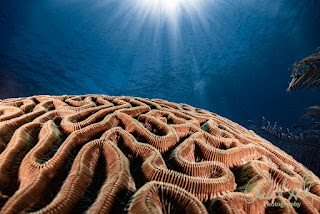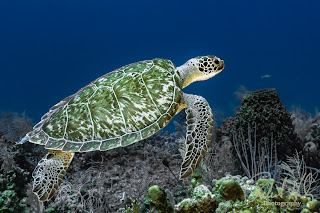The Importance of Monitor Calibration for Underwater Photographers
Hey Oceanic Explorers!
As underwater photographers, one of the most significant challenges we encounter is accurately capturing and showcasing the rich and diverse colors of the underwater environment. The various lighting conditions and unique underwater settings make this task especially demanding. Today, I'd like to emphasize the often underestimated yet essential aspect of post-processing: monitor calibration. Ensuring your monitor is properly calibrated is crucial, it guarantees that the colors and contrasts you observe during post-processing in Adobe Lightroom or Lightroom Classic are faithful to the true underwater hues. Let's delve into the significance of this process and explore how you can accomplish it effectively.
Why Monitor Calibration Matters
Color Accuracy: Underwater photography often involves a complex interplay of light and color. An uncalibrated monitor can distort these colors, leading to inaccurate edits. What looks perfect on your screen might look entirely different on another device or in print. Accurate color representation is essential for ensuring that the vivid blues, greens, and other colors of marine life are faithfully reproduced.
Consistent Results: Calibrating your monitor ensures consistency across different devices. Whether sharing your photos online or printing them, you want them to look as close to your vision as possible. Consistency is key to maintaining the integrity of your work, especially when viewed on various screens with different color settings.
Professional Quality: For those striving for professional-level results, display monitor calibration is a non-negotiable step. It’s a mark of professionalism and attention to detail that can set your work apart. Proper calibration demonstrates your commitment to delivering high-quality images that accurately represent the underwater environment.
How to Calibrate Your Monitor
1. Choose the Right Tools
There are several tools available for monitor calibration. Hardware calibrators, such as the X-Rite i1Display Pro or the Datacolor SpyderX, are recommended. These devices measure the colors displayed on your screen and adjust the monitor’s settings to achieve the correct color profile. Investing in a good hardware calibrator is one of the best steps you can take to ensure color accuracy.
2. Use Built-In Software
Adobe Lightroom and Lightroom Classic offer built-in tools to assist with color correction and calibration. While not as precise as hardware calibrators, they can still help improve color accuracy. These tools provide a starting point and can be used in conjunction with other calibration methods for better results.
3. Manual Calibration
If you don’t have access to a hardware calibrator, you can still manually calibrate your monitor. Here’s a simple guide to get you started:
Brightness and Contrast: Set your monitor’s brightness and contrast to default or recommended settings. Ensure the screen isn’t too bright or too dark. Proper brightness and contrast settings are crucial for accurate color perception.
Color Temperature: Adjust the color temperature to around 6500K (Kelvin). This is generally considered a neutral setting and helps in achieving a balanced white point.
Gamma Settings: Set the gamma to 2.2. This setting balances the brightness between the darkest and brightest parts of your image, ensuring that details are visible across the entire tonal range.
4. Calibration Software
Once you have your hardware calibrator, follow the software’s instructions. Here’s a general overview:
Install the Software: Install the calibration software that comes with your device. This software will guide you through the calibration process step-by-step.
Run the Calibration: Follow the on-screen instructions to measure and adjust your monitor’s colors. The calibrator will display a series of color patches and measure how they appear on your screen.
Save the Profile: Once the calibration is complete, save the color profile. This will be used by your operating system to ensure accurate colors. Make sure to set this profile as the default display profile in your system settings.
5. Regular Calibration
Monitors can drift over time, meaning their color accuracy can degrade. It’s a good practice to recalibrate your monitor every month or so to ensure consistent results. Regular calibration helps maintain color accuracy and ensures that your edits remain reliable over time.
Additional Tips for Underwater Photographers
Ambient Lighting: Ensure that the ambient lighting in your editing environment is consistent. Changes in room lighting can affect how colors appear on your monitor. Ideally, edit in a room with controlled lighting to avoid any color shifts.
Monitor Hood: Consider using a monitor hood to shield your screen from ambient light. This reduces glare and reflections, allowing you to see colors more accurately.
Soft Proofing: Use soft proofing in Lightroom to simulate how your images will look when printed. This feature helps you make necessary adjustments to ensure that your prints match your screen.
Conclusion
By calibrating your monitor, you’ll ensure that your underwater photos' stunning colors and contrasts are accurately represented. This step is essential for achieving professional-quality results and maintaining consistency across different viewing platforms.
If you have any questions or need further assistance, please leave a comment or send an email to bob@robertherb.com.
Stay Connected
Follow my blog for more tips and tutorials on underwater photography. Let's dive deeper into the art and craft of capturing the marine world!
Subscribe to my blog for more tips and tutorials on underwater photography. Don’t forget to share your processed photos on social media using the hashtag #RobertHerbPhotography. I look forward to reviewing your results.
New Online Training Program
I am excited to announce that I am creating an online training program to teach underwater hobbyists and enthusiasts how to enhance their photos using Adobe Lightroom. If you are interested in this training, please contact me at bob@robertherb.com to express your interest and to be notified about the details and start date of the classes.
Stay tuned and "Follow" for upcoming blogs on underwater photography tips and tricks for more in-depth insights. Please leave your comments and suggestions. Enjoy your diving and shooting experience!
I am eagerly anticipating your valuable feedback and suggestions.
Sincerely,
Bob Herb
|
|





Comments
Post a Comment
Please let me know your comments.